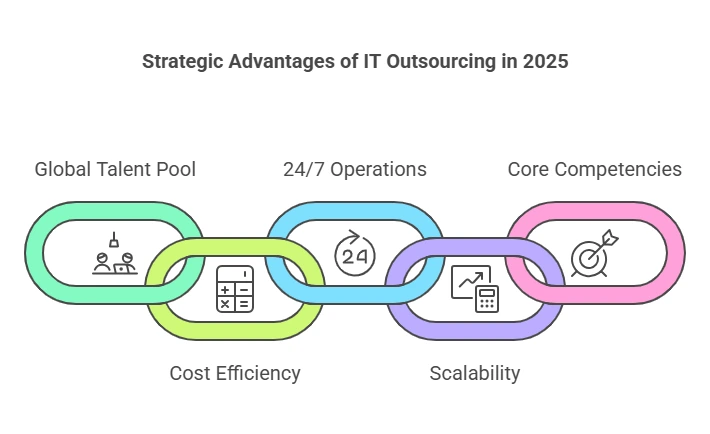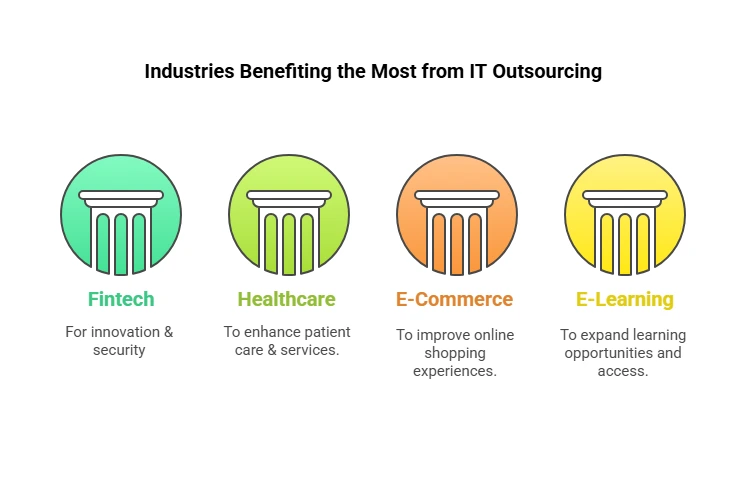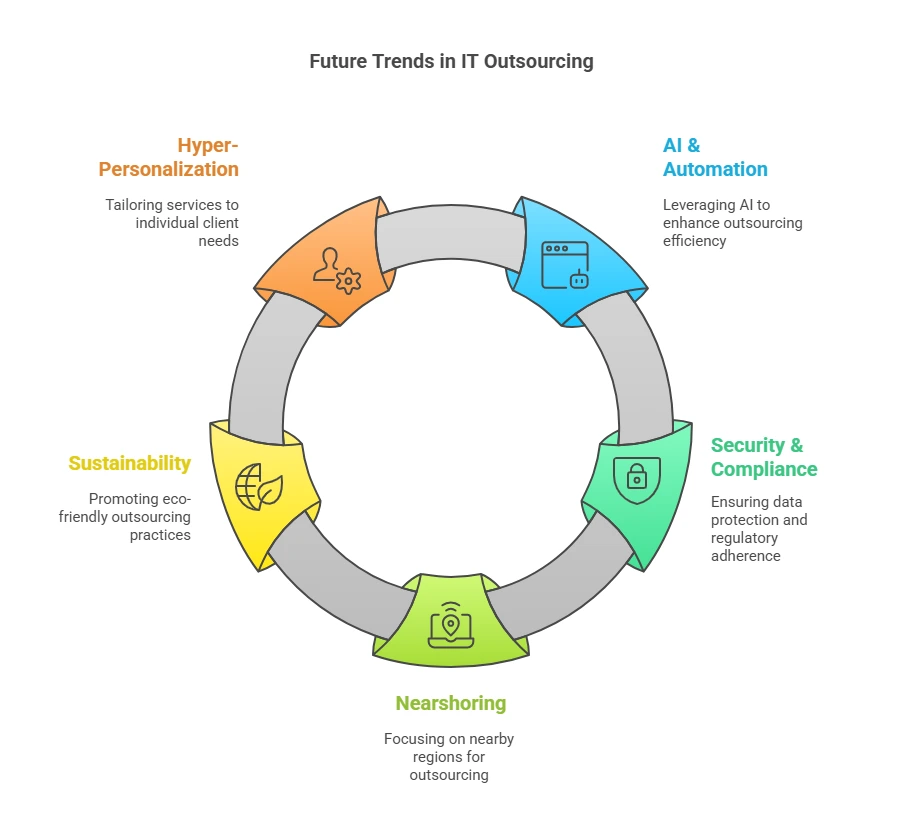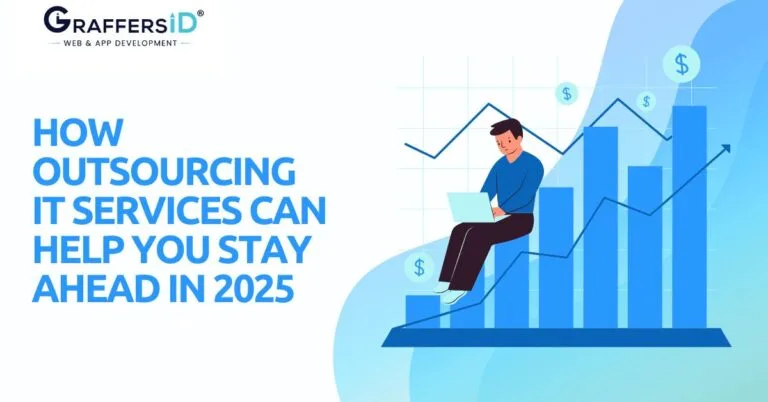In a tech landscape where digital transformation determines market success, businesses are under constant pressure to innovate while reducing costs. IT outsourcing, particularly offshore outsourcing, has become a strategic choice for businesses wanting to scale efficiently, gain access to specialized talent, and stay competitive in the constantly evolving technical industry.
Due to developments in AI, cloud-based collaboration, and security compliance, there will be an even stronger shift toward outsourcing by 2025. This article focuses on the important benefits, challenges, and future trends influencing IT outsourcing this year.
Read More: Eight Most Costly Mistakes in Software Development Outsourcing
Why Companies Prefer IT Outsourcing in 2025

1. Access to Global Talent Pool
The demand for skilled IT professionals is outstripping supply in many local markets, making it challenging for businesses to find the right talent. Outsourcing IT services enables companies to tap into a global pool of highly skilled professionals. These individuals often bring diverse experiences and innovative approaches to problem-solving, helping businesses stay ahead of their competitors. Whether it’s software development, cybersecurity, or data analytics, offshore providers have experts ready to deliver.
2. Cost Efficiency
Cost savings is one of the most convincing reasons as to why firms go for outsourcing IT services. When hiring an in-house team, there are a lot of costs that need to be accounted for salaries, benefits, office space, and training. On the other hand, offshore service providers are usually situated in areas where labor costs are low, thus enabling the company to attain the same quality of work without incurring the expenses that accompany it.
3. 24/7 Operations with Time Zone Advantage
In today’s globalized world, customers expect round-the-clock services. Outsourcing IT services use this time zone difference between the countries to help with this situation. While the local team logs off, offshore associates work on their assigned tasks to ensure that there is no downtime in progressing projects. It is highly advantageous for customer support and other IT maintenance activities and any time-sensitive job.
4. Enhanced Scalability
Business needs can change quickly, particularly in industries like technology and e-commerce. Outsourcing IT services allows companies to scale their operations up or down based on demand. For example, during peak seasons, companies can easily integrate additional offshore team members. Similarly, they can downsize when demand decreases, thus avoiding the complications of laying people off or having underutilized staff.
5. Focus on Core Competencies
By outsourcing IT tasks, companies can focus on what they do best- be it innovating and developing new products, providing world-class services, or growing their market share. Offshore teams handle the time-consuming day-to-day IT operations, allowing remote teams to direct their attention toward strategic priorities and core business functions.
Key Benefits of IT Outsourcing in 2025

1. AI-Powered Efficiency
IT companies with bases outside the country increasingly use artificial intelligence to economize on processes. AI-enabled tools help in software development, testing, and maintenance, minimizing errors that human beings would cause and speeding up project timelines. This helps save on both cost and time.
2. Advanced Cloud Collaboration
With the increase in cloud technology, working with offshore teams is easier than ever for companies. Various tools like Microsoft Azure, Google Workspace, and Slack allow smooth communication, data sharing, and task management in real time. This seamless integration ensures that offshore teams remain an extension of the business, maintaining transparency and efficiency throughout the project lifecycle.
3. Cost-Effective Innovation
In 2025, staying competitive will require adopting the latest technologies. Offshore IT providers often specialize in these areas, offering innovative solutions that would otherwise require a significant investment in in-house expertise and infrastructure. By outsourcing these tasks, businesses can play with cutting-edge technologies without bearing the full cost.
4. Enhanced Data Security & Compliance
With cyber threats on the rise, offshore IT providers are prioritizing security by implementing advanced encryption, secure cloud storage, and compliance with global standards like GDPR and HIPAA. Companies can outsource IT services without compromising on security and regulatory requirements.
5. Sustainability
Sustainability is no longer optional, and in 2025 it will become a business imperative. Offshore IT providers are increasingly adopting eco-friendly practices, such as energy-efficient infrastructure, renewable energy sources, and remote working models. Joining hands with such service providers not only aligns with corporate social responsibility goals but also appeals to eco-conscious customers and stakeholders.
Industries Benefiting the Most from IT Outsourcing in 2025

1. Fintech
The fintech industry is thriving, and outsourcing IT services plays a crucial role in its growth and development. Companies in this field rely on offshore teams for building secure platforms, integrating blockchain technology, and developing AI-driven analytics tools. By outsourcing, fintech firms can deliver innovative products faster while making sure that they comply with strict security regulations.
2. Healthcare & Telemedicine
The healthcare industry is increasingly turning to outsourcing IT services for solutions that enhance patient care and streamline operations. From telemedicine platforms and electronic health record systems to AI-powered diagnostic tools, offshore teams assist healthcare providers in staying in sync with the innovation curve while looking out for costs.
3. E-Commerce & Retail
In the highly competitive world of e-commerce, outsourcing IT services like web development, mobile app creation, and inventory management provides a significant edge to companies. These providers also specialize in building personalized recommendation engines, optimizing search algorithms, and ensuring secure payment gateways, all of which are crucial for e-commerce success in 2025.
4. EdTech & E-Learning
The EdTech industry has transformed the way of learning, and offshore IT services play an important role in this paradigm shift. They help develop scalable learning management systems, virtual classrooms, and interactive content, ultimately making education accessible and effective for learners worldwide.
Overcoming Common IT Outsourcing Challenges in 2025

1. Communication Barriers
Cultural and linguistic discrepancies could hinder effective communication between the onshore and offshore teams. However, collaboration tools like Slack, Microsoft Teams, and Asana can resolve such issues. Additionally, regular video calls and clear documentation can help ensure everyone is on the same page.
2. Time Zone Differences
While time zone differences offer advantages like round-the-clock operations, they can also create scheduling challenges. To overcome this, companies can establish overlapping working hours or designate specific times for team meetings to minimize disruptions.
3. Cultural Differences
Different working cultures create misunderstandings or expectations misfits. Calling for cultural sensitivity training for onshore and offshore teams can help ease the situation. Also, creating an inclusive environment where everyone feels among their own will help bridge gaps in culture.
4. Quality Control
To oversee offshore projects properly, rigorous oversight is needed. The standardized development practices should be implemented within individual companies, along with performance measure tools, and with specific quality benchmarks to meet the marks.
5. Data Security Concerns
With outsourcing tasks comes the clause of entrusting sensitive information with stranger companies, which invites the problem of security. Offshore providers that can employ end-to-end encryption, safe transferring of different types of data, and full compliance with all international laws on data protection do away with such threats.
How to Choose the Right IT Outsourcing Partner
Choosing the right IT outsourcing provider is important for enhancing efficiency, reducing risks, and achieving long-term business growth. A strategic outsourcing decision can determine whether your business acquires a competitive advantage or experiences operational issues.
To select the best IT outsourcing company, follow this process:

1. Define Your Goals and Requirements
Before contacting outsourcing firms, outline your goals:
- Specify the specific IT services you need (e.g., software development, IT support).
- Select the technologies and skills required for your project.
- Establish a budget and timeframe to ensure financial and operational feasibility.
Having a defined plan will assist you in clearly communicating expectations and choosing a partner that fits with your business strategy.
2. Research Industry Expertise & Reputation
Not every IT outsourcing company has expertise in your sector. Select a partner with:
- Proven experience in your industry (e.g., fintech, healthcare, e-commerce).
- Case studies highlighting successful projects similar to yours.
- Client reviews and testimonials on websites such as Clutch, GoodFirms, and Glassdoor.
3. Assess Security & Compliance Standards
Cybersecurity is not an option in IT outsourcing. Evaluate a provider’s:
- Data protection protocols, including encryption, secure servers, and multi-factor authentication.
- Compliance with global regulations such as GDPR, HIPAA, and SOC.
- Track record in cybersecurity & disaster recovery to ensure business continuity.
4. Evaluate Scalability of Services
Your company will expand, and your IT partner needs to scale with you. Look for:
- Agile engagement models like fixed pricing, hourly rates, or dedicated teams.
- Team size increases or decreases as per the workload.
- Proven experience managing large-scale projects with expanding business needs.
5. Assess Communication & Collaboration Methods
Good communication is important when working with offshore or nearshore teams. Check for:
- Availability in overlapping time zones to collaborate in real-time.
- Use of modern communication and project management tools like Slack, Jira, Asana, and Microsoft Teams.
- A proactive support approach that focuses on preventing issues before they arise.
6. Review Pricing Models & Contract Terms
Pricing should be transparent and scalable to align with your budget. Before finalizing a deal, compare:
- Fixed pricing for a clearly defined project with clear deliverables.
- Hourly pricing for ongoing or flexible requirements.
- Dedicated team model for long-term collaboration.
7. Conduct a Trial Project or Pilot Run
Instead of entering into a long-term contract immediately, test the vendor’s capabilities with a small-scale project. This helps evaluate:
- Quality of work done by the outsourcing partner.
- Deadlines and overall efficiency.
- Communication and collaboration effectiveness.
8. Finalize the Agreement & Launch the Project
Before signing the final contract, make sure the agreement has:
Service Level Agreements (SLAs) with clear performance benchmarks.
Project timelines & milestones to prevent delays & inefficiencies.
Exit strategy & contingency plans in case the collaboration fails.
By following this structured approach, businesses can ensure they pick the best-fit outsourcing partner for 2025 and beyond.
Looking for a Trusted IT Outsourcing Partner?
GraffersID provides tailored outsourcing solutions to help businesses scale efficiently. Get in touch today to discuss how our expert offshore teams can accelerate your growth and innovation.
Read More: Advantages and Disadvantages of Outsourcing
Future Trends in IT Outsourcing

1. AI & Automation Driving Outsourcing
AI is a game-changer in this revolutionary outsourced process. It enables offshore teams to automate repetitive tasks, utilize AI for predictive analytics, and invent artificially intelligent solutions that drive efficiency and innovation.
2. Increased Security & Compliance
The increasing sophistication of cyber threats has forced offshore IT service providers to pay more attention to cybersecurity services. As such, they adopt secure development practices, incorporate advanced tools for threat detection, and offer compliance solutions to business clients, which will be very important in 2025.
3. Expansion of Nearshoring
While offshore outsourcing remains popular, nearshoring is gaining traction. Nearshoring combines the cost benefits of outsourcing with the convenience of geographical and cultural proximity, offering a middle ground for businesses.
4. Sustainability
Offshore IT service providers are now adopting green IT practices to reduce their environmental footprint. The application of these green IT initiatives includes engaging in renewable energy usage, implementing energy-efficient infrastructures, and working at home to reduce carbon emissions. This will be a business imperative in 2025, as everyone is growing more conscious about their practices and how it affect the environment.
5. Hyper-Personalization of Services
As businesses opt for solutions tailored to their needs, offshore IT providers are focusing on exactly this aspect as they shift their model to one that is hyper-personalised. This trend involves creating customized services and solutions that cater specifically to the unique needs of each client.
Conclusion
IT outsourcing is no longer just about cost savings—it’s a strategic necessity for businesses looking to innovate, scale, and remain competitive in 2025. By leveraging AI, cloud-based collaboration, and cybersecurity compliance, companies can maximize the benefits of offshore IT services while mitigating challenges.
If you’re looking to optimize your IT operations, GraffersID specializes in providing dedicated remote developers and customized IT solutions to assist enterprises in scaling efficiently.





